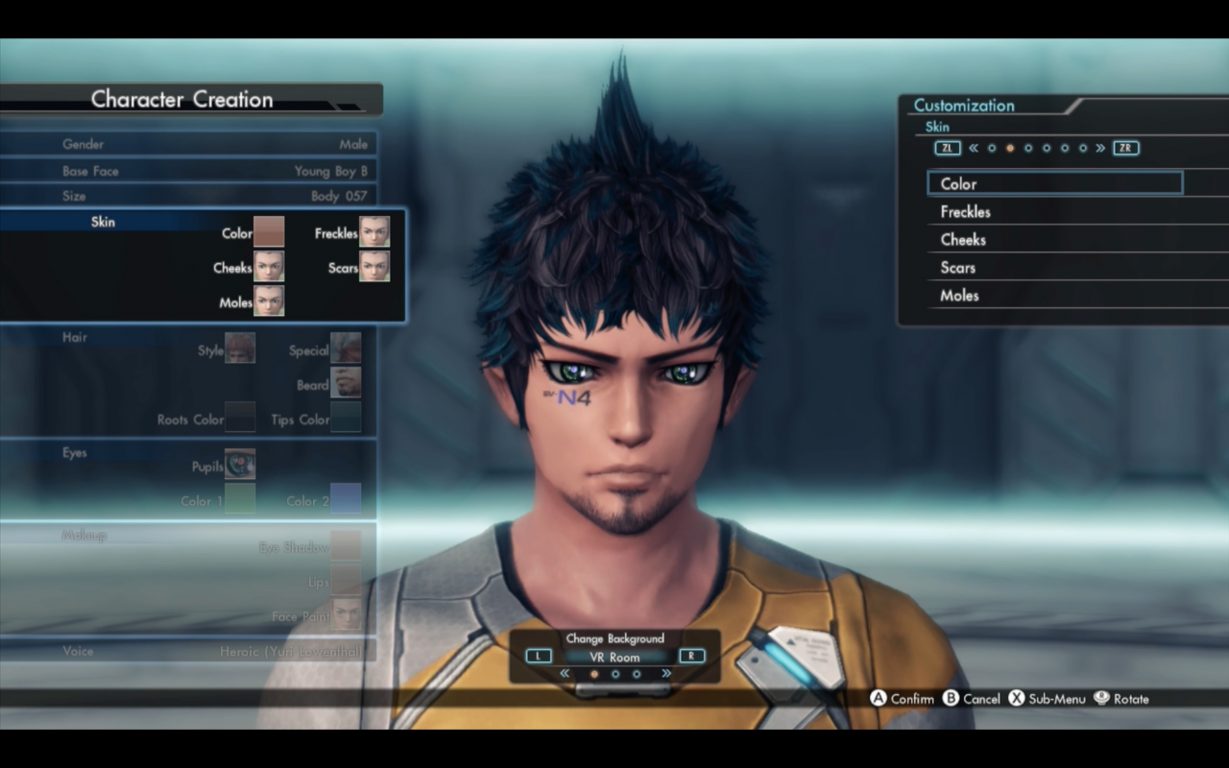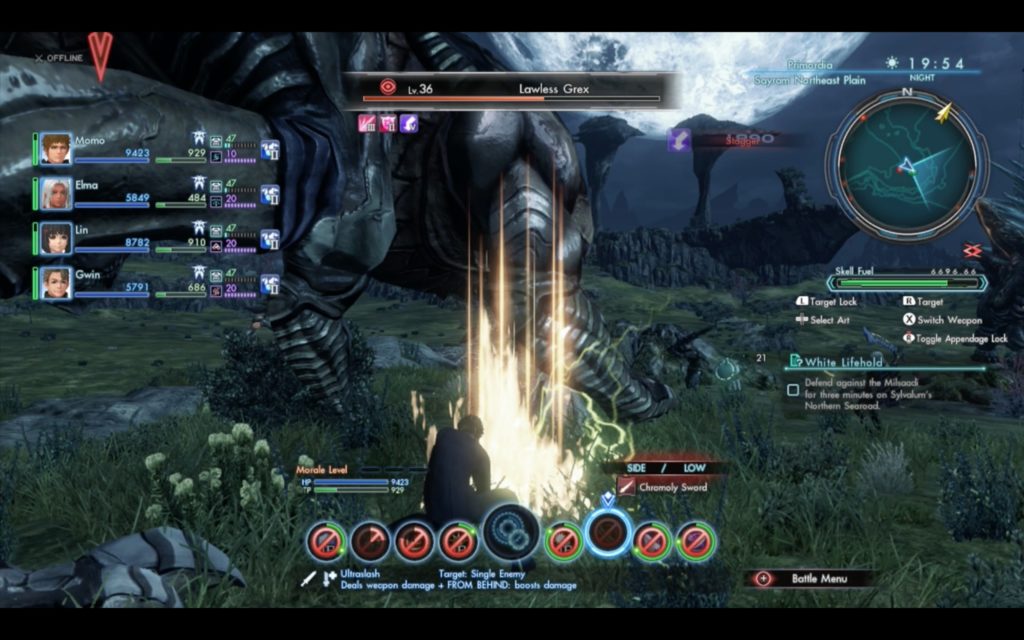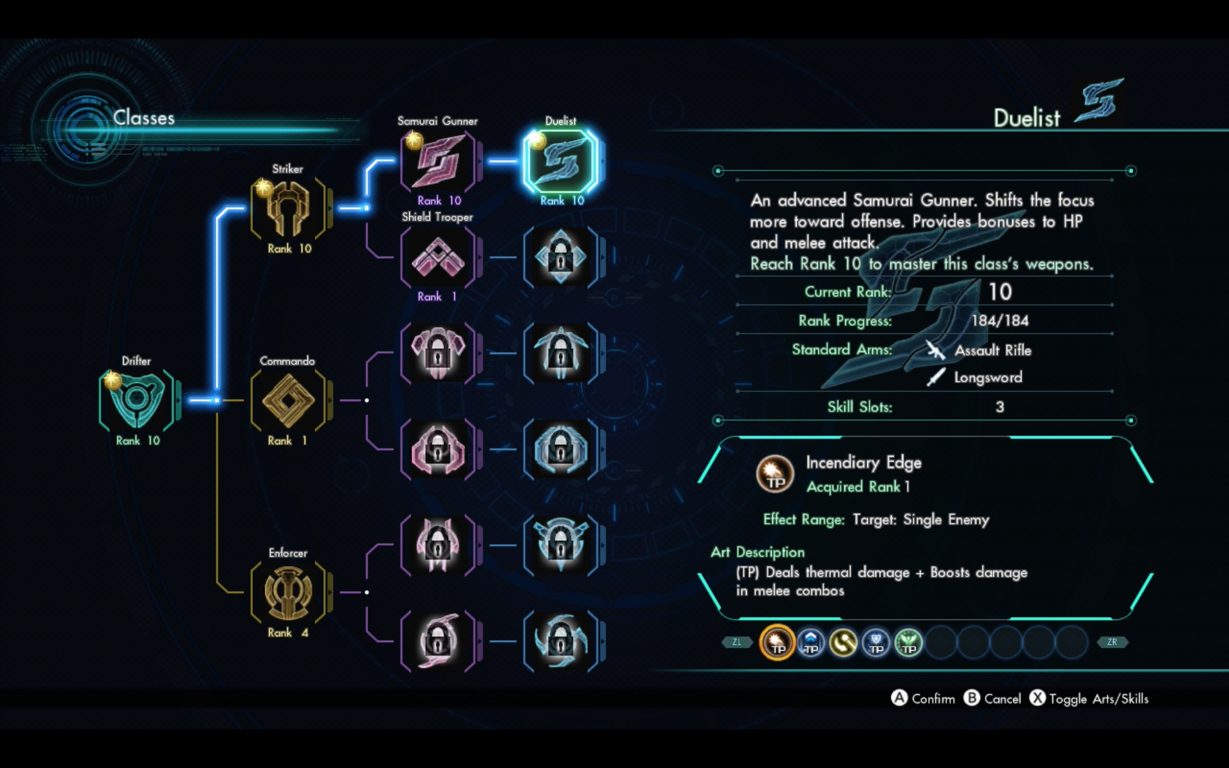Xenoblade Chronicles X came out on December 4, 2015. It was released on a dying system, didn’t have much marketing, yet still managed to sell almost one million copies worldwide. It was also the only Wii U game that Nintendo released in 2015. We thought it would be interesting to take a look back at the game with the release of Xenoblade Chronicles 2, which we will continue to play, as we’re beginning to realize Xenoblade is the new Final Fantasy. The review was by Morgan Lewis, our Editor-in-Chief, for another outlet, and he retains ownership of the review.
Xenoblade Chronicles X comes from a lineage of a long line of Xeno games that span 17 years, four different console generations and two different developers in Squaresoft and Monolith Soft. Monolith now finds itself a subsidiary of Nintendo, which acquired the developer from Bandai Namco in 2007. While there was much criticism of Tetsuya Takahashi because of the elongated cutscenes and linear gameplay in his previous endeavor, Xenosaga Episodes I-III, the story was top-notch, even if the execution was lacking. Once Nintendo took ownership of Monolith Soft, Takahashi, the mastermind behind all the Xeno games, began to take a different approach towards creating RPGs.
Xenoblade Chronicles for the Wii came out in 2010 in Japan and 2012 in North America and had a completely open world, allowing players to not only play through an epic story but explore the world and complete sidequests at their leisure. This gave the player a great amount of freedom. It was incredibly popular, reinvigorating the JRPG genre and selling close to one million units worldwide despite a limited release in North America. Xenoblade Chronicles X is a spiritual sequel to Xenoblade Chronicles and the latter set the groundwork for one of the most involved and definitive RPGs of all time.

Xenoblade Chronicles X takes place after events that forced humanity to flee their homeland and enact the Earth Colonization Project to ensure the survival of the human race. Technologically advanced alien races sought to destroy humanity once and for all, so in preparation, citizens were evacuated onto ships in search of a new home. Many ships were lost in the crossfire trying to escape Earth, and the White Whale, the ship that your “avatar” is aboard, crashes onto the planet, Mira.
After the opening cutscenes play out you are able to completely customize your character, something never done in a Xeno game before. It is actually pretty in-depth and you can make some interesting looking characters, to say the least. In my case, I chose to create a character that at least resembled myself somewhat, although I added a tattoo to my face. Being a “blank slate” also immerses you into the world, allowing you to take on your own identity and form your own emotional responses to events, which I found very rewarding.
It is at the very beginning of the game that you meet Elma, one of BLADE’s highly ranked members, and she guides you on your journey to New Los Angeles, the last sanctuary of mankind. This is where your path as a BLADE operative begins. The main party members in the game are Lin and Elma, and they participate in every one of your story missions. There are five additional primary squad members you can use as a part of the main story, with your party maxed out at four, but through Affinity quests I’ve discovered two additional party members and am uncertain of any other hidden gems, but with a game with so much content, there are bound to be more.

The structure of the game is very different than Xenoblade Chronicles and the story missions are split up into 12 chapters. Before you can advance to the next story chapter, you must meet certain requirements, such as reaching a specific level, surveying a certain percentage of a continent on Mira, or complete specific Affinity quests, which add to character development. A lot of Affinity quests are optional, yet they still add a great amount of depth that you miss out on if you simply play the game straight through. There are also a number of sidequests — too many to count actually — that are unlockable as the game progresses. Some are even continuations of previous ones, which gives the world both a sense of continuity and gives NPCs a chance to develop.
In Xenoblade Chronicles X, a conglomerate of aliens known as the Ganglion are hell bent on wiping out the entire human species out of fear for reasons yet explained. They have followed humanity all the way to the planet Mira after the destruction of Earth to fulfill this sole purpose. It is up to your party to stop the Ganglion and recover as much of the White Whale as possible before Ganglion forces destroy it.
The story does carry some of the traditional Xeno themes, such as human beings’ intrinsic will to survive, and many of the Gnostic and Jungian references are much more subtle than previous games (especially when it comes to naming). The story is a classic science fiction-fantasy though, and it is not without its surprises. The cutscenes aren’t too long and I never felt pulled out of the game — in fact, I was entranced and couldn’t wait to see what happened next. While the stakes in the game are dire, it does have its lighthearted moments, mostly revolving around Tatsu — a Nopon — who see their race return from the original Xenoblade.

Xenoblade Chronicles X shares a very similar battle system with Xenoblade Chronicles, yet it is slightly tweaked. Players now build up Tension Points by auto-attacking. Arts function the same way they did in Xenoblade Chronicles and can be learned and leveled up over time. Some arts require a certain amount of Tension Points to be used, but if you save your Tension Points and allow them to accumulate to 3,000, you can revive allies or go into Overdrive Mode. Overdrive Mode allows your character to make use of tertiary cooldowns, which enhance your arts’ strength.
Cooldown speeds for arts are accelerated and Overdrive Mode has a countdown and provides bonuses. The higher the counter goes, the more effective your bonus will be. Some of the bonuses you can receive can extend the amount of time your Overdrive Mode lasts, allow you to receive bonus Tension Points for each attack you make, or increase the damage dealt when you attack. If you receive another 3,000 TP in Overdrive Mode, you can initiate it all over again and simply rinse and repeat.
Overdrive Mode has its benefits, but I generally played a bit more traditionally as all of my favorite attacks required TP, especially once I had an enemy toppled (a function which returns from Xenoblade). There are times to save up for Overdrive Mode, such as with bosses, but others where you simply do not need it. Attacking with Skells keeps the same battle system, with an added bonus: attacking doesn’t require any TP, so accruing the required 3,000 TP to go into Overdrive Mode is not as hard and helps immensely in difficult situations, especially as you get further into the game and face higher leveled enemies.
You can also target enemy appendages and destroy them, which keeps them from performing certain attacks that rely on the appendages’ corresponding body part. For bosses, this is incredibly helpful when trying to keep them from performing devastating attacks that deal a significant amount of damage.
Xenoblade Chronicles X is a very customizable game, making it incredibly intricate with several different types of ranking systems. When you join BLADE, you are given a choice to join one of eight factions, all of which have different jobs to both keep New LA safe and help find the Lifehold, a part of The White Whale. It’s not a huge deal which faction you choose, as you will end up doing other factions’ jobs as well as attending to your own duties.

What does matter is your BLADE ranking, which is leveled up by gaining points from completing tasks that pertain to your own faction’s role in New LA. Leveling up your BLADE ranking will allow you to level up three different skills: mechanical, archeological, and biological. These allow you to unlock treasures and plant probes. It is highly recommended that you level up your mechanical ranking as fast as possible, as this is how you are able to plant probes and mine Miranium, making some easy credits on a daily basis in the process.
Miranium has a number of uses, from fueling up your Skells, handing some off to clients for quests, purchasing Augments, and investing in corporations. Yes — Xenoblade Chronicles X allows you to invest in corporations! You actually invest Miranium in Arms Manufacturer’s corporations in order to level them up. They, in turn, are able to make brand new gear for purchase.
There are new corporations that you unlock throughout the game and it makes for a variety of different weapons and armor to choose from. Another new feature are Augments, which allow you to attach attributes onto characters, Skells, and equipment of any sort. They seem to replace the gem feature found in Xenoblade Chronicles, and although there are many different Augments and types of Augments, it can be difficult to procure the materials needed to create them. You can even make your own weapons once you reach a certain level, but I haven’t found a good portion of the materials to be able to do these things as of this point. Xenoblade Chronicles X is a game you can put hundreds of hours into, so I’m sure I’ll be rewarded by this system, but early on it’s not entirely helpful.

There are also 16 different classes you can unlock for your character. Everyone starts out as a Drifter, wielding a knife and an assault rifle. As you level up your class and reach the level cap, you can advance to another class. There are three different branches to choose from, each diverse in the weapons that they wield. I decided to go with a longsword and an assault rifle, maxing out as a Duelist, as I found it to be a lot of fun, but you can actually unlock every class and give yourself a multitude of options.
This becomes very useful when deciding who to take along on your missions as your fourth party member because different party members are locked into different classes. Giving yourself diversity among your party is very helpful in combat. As you progress along a certain class path, you ultimately unlock more “skills”, which give you additional attributes, such as a higher melee attack or additional health. You can use Battle Points to level up skills, as with arts, which both max out at level five.
One thing I haven’t touched upon yet in detail are Skells — and for good reason, as they are in a class of their own. Skells are simply a blast, especially when you attain the flight module. Once you get that, as if the world wasn’t large enough already, Mira truly opens up and you can finally visit the fifth continent, Cauldros. I simply cannot express how much fun it is to just fly around in my Skell, not only fighting enemies but admiring the beautiful landscape of Mira. You can completely customize the look of your Skell in the BLADE Barracks to personalize it and even give it a name. Skells also have a level up system of sorts. You receive your first Skell which is ranked at level 20. When you reach level 30, you can buy new Skell frames — though for a hefty sum — and also buy more powerful weapons for it.
Making money isn’t hard in the game, but buying Skells for each of your teammates can be simply because of the cost. Skells have an insurance policy so you can wreck it a total of three times before paying to have it repaired. There is a workaround though; you can bail out of your Skell just before it is destroyed and won’t lose insurance on it. This saved me quite a few times. Skells also allow you to take on large and powerful enemies that otherwise would be very difficult to take out on foot. They are simply so much fun (in large part due to flight mode), the weaponry is really powerful, and flying around all of Mira is such a freeing feeling.

The world of Mira is absolutely gorgeous and Monolith Soft outdid themselves with the open-world aspect of the game. Everything loads seamlessly — meaning no loading times at all as you explore the world and I experienced no framerate drops. There are five continents to explore, three of which are connected by land, one of which is reachable by water, and another which is only reachable by flight. The world is supposedly said to be larger than Fallout 4, Skyrim, and The Witcher 3 combined; I’m not so sure about that, but it is the largest game world I have ever had the pleasure of traversing. From time-to-time, you will run into enemies that are a much higher level than you, and in this case, I found that there’s only one strategy: run!
You can also fast travel throughout Mira by way of different landmarks you have discovered and by planting probes throughout the planet. The world map is displayed on the GamePad and it does a brilliant job of showing you where you can fast travel, where you have planted probes, where you can plant probes, and where to find various quests and treasures. It also allows you to upgrade standard probes to increase revenue or the materials you mine.
Xenoblade Chronicles X is the best looking game on the Wii U, and that is because of the environments found throughout Mira — they are absolutely stunning! Everything is so detailed and each locale is so diverse and made up of volcanoes, forests, deserts, grasslands, and even a crystal-like environment. There is even a phenomenon you can see every so often similar to the Northern Lights, which is simply breathtaking. Mira is not only enormous, but it is the most beautiful thing to grace the Wii U, and that’s quite a feat considering the vastness of the world and how much of the Wii U’s power it must have consumed to generate.

Hiroyuki Sawano comes in and composes the score for Xenoblade Chronicles X and he surpasses all expectations. With his rise to fame for composing the music for anime such as Aldonah.Zero and the massive hit Attack on Titan, Sawano shows a level of versatility in his music, from the upbeat theme of New LA to some of the dramatic and emotional music found in the most poignant moments in the game. The battle music really gets you in the mood to fight and each continent has its own theme for both day and night, putting you in an adventurous spirit.
Xenoblade Chronicles X is one of those games that comes around maybe once every decade or so. Its enormous scope, compelling story and characters, the sheer amount of customization, incredible music, beautiful graphics and environments, and — I have to highlight — giant flying mechs make for a once in a lifetime experience. This doesn’t even take into account the online mode (note: it’s not fully functional at this point) that allows you to play in squads of up to 32 different people to complete difficult quests and lets you pick up other players’ avatars for help, having them join your party for a limited time.

The scary thing is that this seems like the first part of a grander story, and we may have a part two, either through DLC or another game altogether. Xenoblade Chronicles X puts the Final Fantasy games to shame and is the best RPG of the last decade. It took me roughly 85 hours to complete the main quest, but there is still so much to do afterward that you could literally spend hundreds of hours on this game. This is Tetsuya Takahashi’s masterpiece and in his words,
“15 years have passed since Monolith was founded, and I believe that with this game I have finally met the challenge I had within me, of creating an RPG in which humans and robots can co-exist.”
- Fighting in Flying Mechs is AWESOME
- Massive world to explore
- Excellent story with good character development and plenty of sidequests
- May be too much of a time investment for some
- Small UI Text
